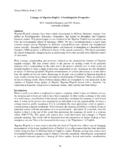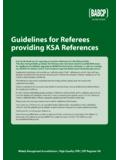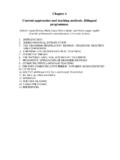Transcription of Teaching Strategies GOLD Assessment System
1 Outcomes StudyLeveL O f e videnceGold Standard Teaching Strategies gold Assessment System Technical SummarySummary findings of a Study conducted by The center for educational Measurement and evaluation The University of north carolina at charlotte 2011 Teaching Strategies , Inc. All rights reserved. IntroductionSelecting a Meaningful Assessment InstrumentWhen selecting an Assessment instrument to administer to children, the most important considerations are the validity and reliability of the measure. Validity refers to what the Assessment tool measures and how well it does so. Reliability refers to the consistency of scores obtained for the same children when reexamined with the same Assessment instrument on different occasions, with different sets of equivalent items, or under other variable Assessment conditions.
2 To ensure that Teaching Strategies gold is both valid and reliable, The Center for Educational Measurement and Evaluation (CEME), The University of North Carolina at Charlotte, conducted extensive research with thousands of children and teachers. This document is a summary of the results obtained from that Strategies gold Assessment SystemTechnical Summary2 Technical SummaryTeaching Strategies gold OverviewTeaching Strategies gold is an authentic observation-based Assessment System for children from birth through kindergarten. The System may be implemented with any developmentally appropriate curriculum. It blends ongoing observational Assessment for all areas of development and learning with performance tasks for selected predictors of school success in the areas of literacy and numeracy.
3 Teaching Strategies gold can be used to assess all children, including English- language learners, children with disabilities, and children who demonstrate competencies beyond typical developmental expectations. Using Teaching Strategies gold The primary purpose of Teaching Strategies gold is to document children s learning over time, inform instruction, and facilitate communication with families and other stakeholders. It is important to remember that Teaching Strategies gold is not intended as a screening or diagnostic measure, an achievement test, or a program-evaluation tool. Objectives for Development and LearningTeaching Strategies gold enables educators to focus on and measure the knowledge, skills, and behaviors most predictive of school success.
4 The tool has a total of 38 objectives. Two objectives are related specifically to English language acquisition, and the other 36 objectives are organized into nine areas of development and content-area learning. The areas are Social Emotional Physical language Cognitive Literacy Mathematics Science and Technology The ArtsTechnical Summary3 Technical SummaryTeaching Strategies gold Progressions of Development and LearningTeaching Strategies gold presents progressions of development and learning for objectives in the areas of social emotional, physical, language , and cognitive development and in the content areas of literacy, mathematics, and English- language acquisition. Indicators and examples enable tool administrators to rate children s knowledge, skills, and behaviors on a 10-point scale of Not Yet to level 9.
5 Furthermore, with the exception of those for English language acquisition, the progressions use colored bands to show widely held expectations for various ages (birth 1 year, 1 2 years, and 2 3 years) and for various classes/grades (preschool 3, pre-K 4, and kindergarten). At a glance, these colored bands show educators and families which skills and behaviors are typical for children of a particular age or class/grade. The bands help teachers manage the complexity of young children s development, which Teaching Strategies gold recognizes as being uneven and rapidly changing. They also help teachers and families understand that expectations for a particular age or class often overlap expectations for another.
6 Here is the progression for Objective 1, Dimension a: ,FYa\Zk`m\j ]fi ;\m\cfgd\ek C\Xie`e^1 9`ik_ K_ifl^_ B`e[\i^Xik\eFYa\Zk`m\ ( Regulates own emotions and behaviorsX% DXeX^\j ]\\c`e^jEfk P\k()*+, \j X[lck jlggfik kf ZXcd j\c]:Xcdj j\c] n_\e kflZ_\[ ^\ekcp# gXkk\[# dXjjX^\[# ifZb\[# fi _\Xij X jffk_`e^ mf`Z\Kliej XnXp ]ifd jfliZ\ f] fm\ijk`dlcXk`fe Xe[ Zi`\j# Ylk `j jffk_\[ Yp Y\`e^ g`Zb\[ lg:fd]fikj j\c] Yp j\\b`e^ flk jg\Z`Xc fYa\Zk fi g\ijfe>\kj k\[[p Y\Xi ]ifd ZlYYp n_\e lgj\kJ`kj e\ok kf ]Xmfi`k\ X[lck n_\e jX[@j XYc\ kf cffb Xk X j`klXk`fe [`]]\i\ekcp fi [\cXp ^iXk` ZXk`feN_\e k_\ YcfZb Xi\X `j ]lcc# cffbj kf j\\ n_Xk fk_\i Xi\Xj Xi\ XmX`cXYc\JZfncj# @ [`[e k ^\k kf gX`ek k_`j dfie`e^% GXlj\j Xe[ X[[j# @ _Xm\ Xe `[\X% @ ZXe gX`ek X]k\i jeXZb%.)]]]]]]]
7 Fekifcj jkife^ \dfk`fej `e Xe Xggifgi`Xk\ dXee\i dfjk f] k_\ k`d\8jj\ikj# @ d dX[% Pfl i\ efk j_Xi`e^ k_\ YcfZbj @ d ^f`e^ kf gcXp n`k_ k_\ iXdgj% JXpj# @ d jf \oZ`k\[ N\ i\ ^f`e^ kf k_\ qff kf[Xp n_`c\ aldg`e^ lg Xe[ [fneY% =fccfnj c`d`kj Xe[ \og\ZkXk`fej Efk P\k()*+, \jgfe[j kf Z_Xe^\j `e Xe X[lck j kfe\ f] mf`Z\ Xe[ \ogi\jj`feCffbj n_\e X[lck jg\Xbj `e X jffk_`e^ mf`Z\8gg\Xij Xeo`flj `] mf`Z\j Xi\ cfl[ fi le]Xd`c`XiKflZ_\j k_\ gl[[c\ f] nXk\i n_\e X[lck jd`c\j \eZfliX^`e^cp8ZZ\gkj i\[`i\Zk`fe ]ifd X[lckjDfm\j kf k_\ jXe[ kXYc\ Xk jl^^\jk`fe f] X[lck n_\e k_\i\ Xi\ kff dXep Xk k_\ Xik kXYc\@e`k`Xccp i\]lj\j kf ^f `ej`[\# Ylk Zfdgc`\j n_\e k_\ k\XZ_\i i\jkXk\j k_\ i\hl\jk DXeX^\j ZcXjjiffd ilc\j# iflk`e\j# Xe[ kiXej`k`fej n`k_ fZZXj`feXc i\d`e[\ij@e[`ZXk\j k_Xk fecp ]fli g\fgc\ ZXe gcXp Xk k_\ nXk\i kXYc\.]]]]]]]]]]]]]
8 C\Xej lg n_\e dlj`Z `j gcXp\[>f\j kf i\jk Xi\X n_\e c`^_kj Xi\ [`dd\[8ggc`\j ilc\j `e e\n Ylk j`d`cXi j`klXk`fejNXcbj Xe[ lj\j X hl`\k mf`Z\ `e k_\ c`YiXipIlej Xe[ j_flkj n_\e fe X \c[ ki`g kf k_\ gXibC`jk\ej Xkk\ek`m\cp kf X ^l\jk jg\Xb\iJ\\ gX^\j ( ) f] :_`c[ 8jj\jjd\ek Gfik]fc`f%Rating scaleexpectations for ages and for classes/gradesindicators (in bold)examples (bulleted)Birth to 1 year1 to 2 years2 to 3 yearsPreschool 3 classPre-K 4 class Kindergarten4 Technical SummaryThe Norm SampleDetermining the SampleWhen determining the validity and reliability of an early childhood Assessment instrument, it is important to identify a large sample of children who are representative of the nation s population of similarly aged children.]]]]]
9 Doing so allows teachers and administrators to assume that the instrument will be used equally effectively with children from all parts of the country; children in all types of instructional settings; and children with different backgrounds, races, ethnicities, and special needs. CEME determined the norm sample from a total of 111,059 children rated by using Teaching Strategies gold . The total population was divided into 3-month age bands, for a total of 24 age bands ranging from 0 2 months to 69 71 months. Teachers answered questions about each child s background, race, and ethnicity that were identical to those employed by the Census Bureau. The goal was to represent each of the twenty-four 3-month age bands with 500 randomly selected children.
10 This sampling procedure was used to match the Census Bureau 2009 estimates for children ages birth to 5 years, 11 months with respect to seven ethnic SampleThe final sample used to evaluate the validity and reliability of Teaching Strategies gold retained a total of 10,963 children. This extremely diverse group of children received educational services in 618 different programs at 2,525 different early childhood centers located across the United States. These programs included Head Start, private child care, and school-based sites. Forty-eight states and the District of Columbia were represented in the final sample. A total of 4,580 teachers was selected as raters to administer Teaching Strategies gold .






